Radishes are a great addition to any garden. They are easy to grow, have short growing times, and don’t take up a lot of space. Radishes are also one of the first plants that can be harvested in the spring growing season.
These characteristics mean you can grow a number of radishes in a small space with plenty of growing season for several plantings worth of delicious, crisp radishes.
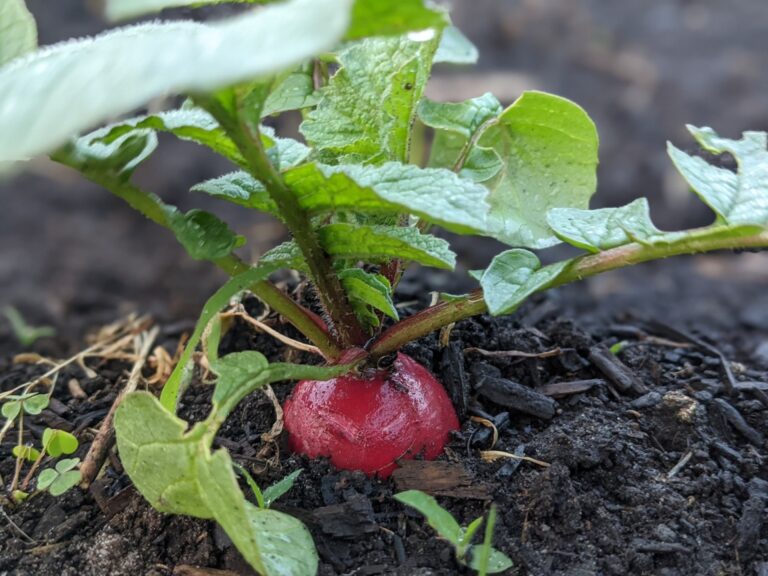
Whether you are a beginner gardener, or a gardening pro, you’ll want to add radishes to your garden space. Keep reading for how to plant, grow, and harvest radishes.
Table of Contents
Location
Radishes are pretty adaptable plants, and will grow well in most growing zones. Anyone in zones 2 through 10 should be able to plant them quite easily.
Keep in mind that radishes don’t like temperatures that are too hot, so when choosing your location, aim to plant them in a part of the garden that gets good afternoon shade, but is sunny during the cooler parts of the day.
If this doesn’t work, you can companion plant radishes with some vegetables that provide a little shade, such as beans and peas. This will help keep your radishes a little bit cooler so they can keep growing in the warmer parts of the summer.
Radish Soil Requirements
Radishes are tough little plants, and will grow in a variety of soil conditions. However, the ideal oil for them is one that drains well. A sandy, loamy type soil with a pH between 5.8 and 6.8 is best for growing radishes.
If you have aged manure or older compost, work that into the soil to increase fertility, soil aeration, and added nutrients for your radishes.
Planting Radish Seeds
You don’t have to be too fussy when you plant your radish seeds. You can simply direct sow radish seeds right into the garden.
Spacing may vary according to the specific cultivar you are growing, and you can usually find that information on your seed packet or in your seed catalog.
However, generally speaking, you can plant your radish seeds about one inch apart, and about half an inch deep into the soil.
If you plant in rows, keep them about a foot apart. If you plant them extra close, you will need to thin out some of the seedlings in order to give them room to grow
Radishes that don’t have enough space may not grow globes or roots properly.
Under the right conditions, seeds will germinate in four to ten days. Most varieties of radishes will be ready to harvest anywhere between twenty two and fifty days, if they are getting enough sunlight, and the right amount of water.
If you plant using square foot gardening, you can easily grow 16 radishes in one square foot. If you are growing smaller radishes, you may be able to fit a few more into your square foot as well.
You may want to succession plant them. Plant a new set of radish seeds every ten to fifteen days. This will help you to have a continuous crop throughout your entire growing season.
Keep in mind that radishes may not do well in the hottest parts of the summer. Plant them in part shade, or they may bolt very quickly, even before their bulbs can form.
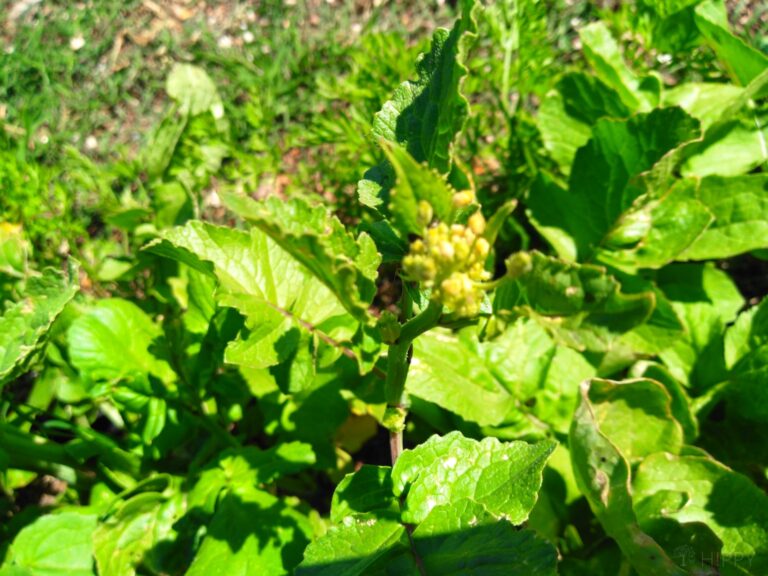
Transplanting Radishes
Radishes should be sown directly into the garden rather than started indoors. They simply don’t transplant well.
It’s also unnecessary to start them indoors because the length of time between planting and harvest is so short.
Companion Planting with Radishes
Because radishes are small, they are a great plant for companion planting with larger, slower growing vegetables.
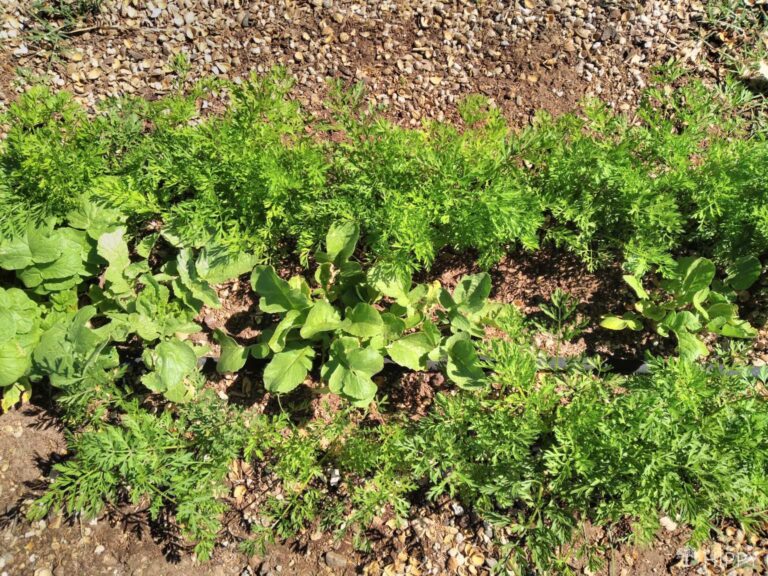
They will also benefit from afternoon shade provided by taller vegetables. They grow well with any of the following:
| ✔ Beans | ✔ Peas |
| ✔ Beets | ✔ Parsnips |
| ✔ Onions | ✔ Carrots |
| ✔ Cucumbers | ✔ Squash |
| ✔ Rosemary | ✔ Nasturtiums (edible flowers) |
| ✔ Lettuce | ✔ Tomatoes |
| ✔ Peppers |
You can plant radishes in-between these vegetables to save space as the larger vegetables mature, or plant them in a row next to them, especially if you need your radishes to receive a little afternoon shade.
Radishes do need some sun, so make sure they’re only being shaded during the hottest part of the day.
Avoid companion planting radishes with:
- ✖ Potatoes
- ✖ Grapes
- ✖ Hyssop
- ✖ Kohlrabi
Watering Radish Seeds
After you’ve planted your radish seeds, you’ll need to water them right away. Water the soil just enough to moisten it, being very careful not to wash away the tiny seeds.
You want the soil to be damp, but not soggy or muddy. A lightly moist soil works best for germination.
Watering Radishes
Radishes need water to grow, but too much will make them split and crack. Too little water will cause the radishes to grow unevenly, which will also make them split and crack.
Try to keep the soil moist, but not soaked because radishes don’t like to have wet feet. Just water them when the soil seems dry.
If the soil is drying out too quickly, you can mulch around the plants to increase the water retention. Try to keep the soil evenly moist at all times for the best radishes.
Germination and Growth Rates
Radishes grow fast, making them an ideal vegetable to start in early spring. It will be one of the first veggies ready for you to eat.
They will germinate anywhere from four to ten days after planting, under ideal conditions. Different types of radishes have different growth rates.
Small garden radishes, such as Cherry Belle, take about 21 days from planting to harvest, under ideal circumstances (with the right soil, lighting, and water).
Other types, such as Daikon, can take as long as 60 days from planting to harvest. Lack of sunlight could make it take longer for the plants to mature.
Winter radishes, such as Chinese White Winter and Black Round Spanish, take longer to mature.
It can take 60 days or longer for these types of radishes to grow from planting to harvest, but they can stay in the ground even after the first frost.
Harvesting
There are many different types of radishes and they ripen at different times. The most common small red radishes are usually ready within three weeks or so of planting.
These little red radishes are generally ready to eat when they are about an inch across.
You’ll most likely have to pull one out to check and see if it is big enough to harvest. If it is, you can pretty safely harvest the rest. Don’t wait too long or the radishes could become too spicy or even bitter and woody.
Daikon radishes can grow large and stay in the soil for a longer period of time before the quality of the radish deteriorates, and it’s no longer palatable.
Just make sure to harvest them before the ground freezes, and they can be stored in cold storage (like a root cellar) for as long as four months.
The best time to harvest radishes is right after a good rain or the morning after they have been watered. This will make the ground nice and soft so you can easily slide the radishes out of the garden.
If you are harvesting larger winter radishes, such as Daikon, you may need to use a garden fork to loosen the soil around them first. Otherwise, the roots may break off when you are harvesting them.
Saving Radish Seeds
If you want to save your own radish seeds for the following year, consider growing only one type of radish because they can cross-pollinate. Cross-pollinated radishes might give you less than desirable results.
Choose heirloom radishes so that the type and quality remain consistent. If you save hybrid seeds for the following year, you might get inconsistent results.
You’ll need to allow a few radishes to bolt. This will make the root inedible, but will provide you plenty of seeds for next year’s garden.
Radishes will send up a tall flower. When the flower fades, it will begin to produce a small seed pod that resembles a bean or tiny peanut.
Leave the seed pod to dry right on the plant. When the pod rattles when you shake it, you are ready to harvest the seeds.
Hold a small paper bag underneath the radish seed pod, and gently cut it off so that it falls into the bag. This will keep you from losing the small pods in the dirt or from losing seeds should a pod break open while you are harvesting them.
You can easily break open the seed pods with your fingers. If you like, you can plant the seeds right away for a new harvest in just a few weeks.
Or you can lay the seeds out on a paper towel, and allow them to dry completely for a few days.
Once they are dry, you can store them in an envelope or jar for next year. Make sure you label your seeds with the type, date harvested, and location so you know what you are planting.
You may also want to include any notes on how well the radishes did in your garden, and any special treatment that you gave them, such as pest control or compost.
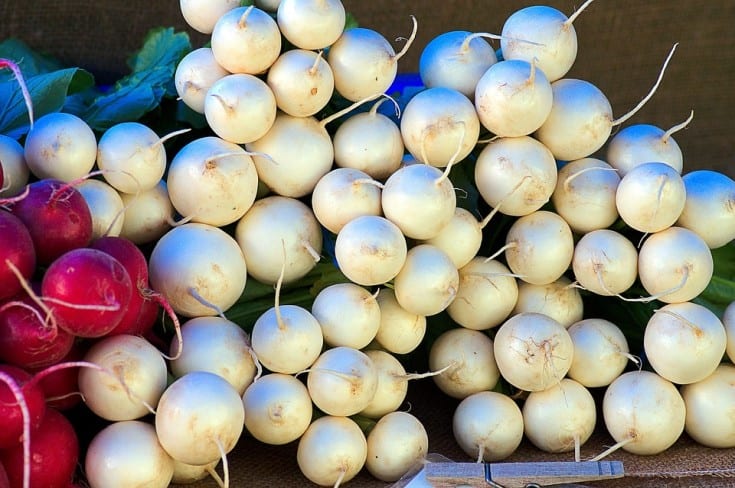
Radish Varieties
The hardest part of planting radishes might just be choosing the variety you like best! These are some popular varieties to try:
- Cherry Belle. The most common globe or round radish is the Cherry Belle. This popular, small red radish has crisp flavor, grows quickly, and is very reliable.
- Sparkler. Sparkler is a red and white garden radish.
- Scarlett Globe. This variety is known to be very easy to grow.
- Juliette F1.
- French breakfast. This delightful variety has a peppery flavor, a crisp crunch, with a long, cylindrical root.
- White Icicle
- Ilka. This is a larger heirloom version of a globe radish and resists becoming woody.
- Plum purple. This radish has a sweet and spicy flavor and a pretty purple color.
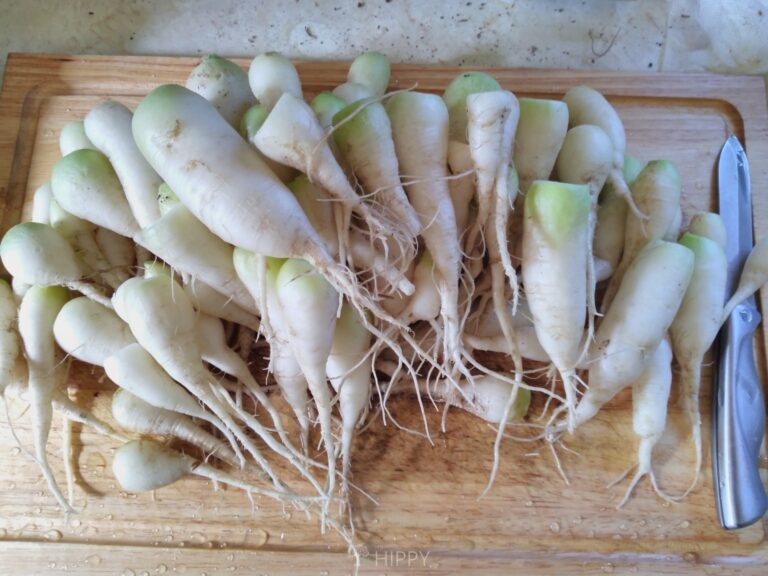
Radishes that can be grown inside include:
- Perfecto. A round, pretty, red radish.
- Sparkler. Sparklers are red at the top, and more white towards the bottom. They are best harvested at about one inch around.
- Ping Pong. This variety is white, inside and out.
- Easter Egg. Harvest these as needed.
- Cherry Belle. This is your standard dinner radish.
Choose your favorite radishes based on flavor, size, time to maturity, and location. Make sure to choose a variety that will grow well in your area.
Fertilizing Radishes
You don’t need to fertilize radishes. They grow so quickly that they don’t have much time to absorb the fertilizer properly.
On the other hand, as radishes grow, too much fertilizer can make them tough and woody because they grow too quickly. Instead, work some aged compost or manure into the soil before you plant your seeds.
This will help super-charge your soil, correct soil issues, and create the ideal growing medium for your radishes.
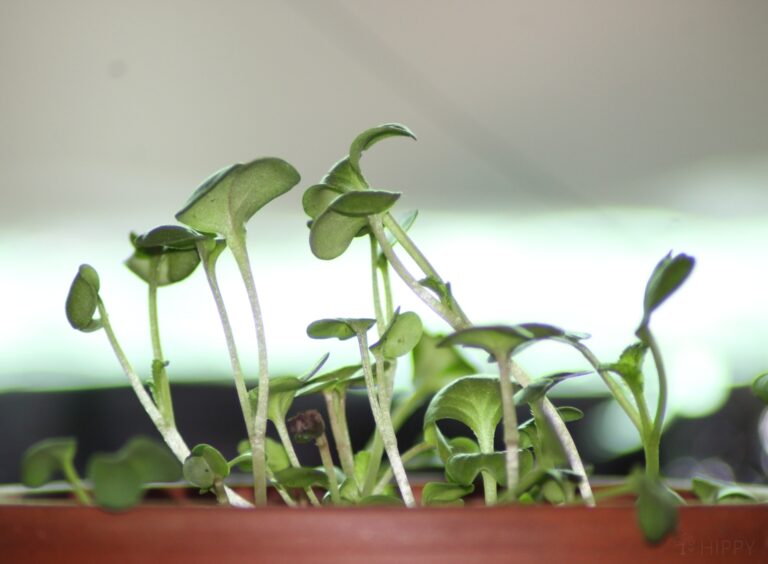
Growing Radishes in Containers
Radishes can easily be grown in containers on a balcony, patio, or in your garden. Spacing is a consideration.
If you are growing radishes in containers, you’ll probably want to grow smaller types such as Cherry Belles.
Choose a pot that is at least six inches deep. Space them as you would in the garden. However, container radishes will probably need to be watered more frequently.
Growing Radishes Indoors
Radishes can be grown indoors, especially when it is too cold to grow them outside. First, you’ll want to consider what variety you are growing.
You’ll need a good size pot that will allow the radishes to grow and reach full size. You’ll want good quality potting soil, with some extra compost and maybe even a little perlite to help them have enough room to grow.
Lighting will be the biggest problem with growing radishes indoors. You need a very sunny window, but still they may get leggy and grow slowly.
So if you want to grow radishes indoors for the winter, you may want to consider using grow lights to give them a good boost of light.
Water the radishes enough to keep the soil moist, but not so much that they are sitting in water or soggy soil.
You can succession plant radishes indoors, or even plant fast and slower growing radish seeds together so that you can have a continuous crop.
Keep in mind that growing radishes indoors will probably mean that they will not grow as quickly as stated on the radish seed packet. Daikon radishes are a hard variety to grow indoors unless you have large pots.
If you have trouble growing full radishes indoors, consider growing radish shoots. They taste very similar to the actual radish, and are full of vitamins and minerals.
You can eat them on salads and sandwiches, just like you would a radish. A great cultivar of radish to grow as sprouts is the Daikon variety.
Radish Problems
Although radishes are fairly easy to grow, they may sometimes have problems. Here are a few common problems and solutions to growing them:
- Too Spicy. If your round radishes are too spicy too eat, that means they have probably been left in the ground too long, or they were too slow to mature because the conditions weren’t right.
- Cracking. Cracking and splitting are typically caused by uneven watering. Make sure you are watering your radishes regularly. If your radishes are only split a little bit, they are still edible.
- Woody and Tough. Generally, radishes that are woody and tough have been left in the ground for too long. Try harvesting them sooner or planting them earlier in the season so they grow faster.
- No bulbs have formed, and the plant is just leaves. If there are no bulbs growing, there are several possible reasons. This could be because the weather is too warm and the plant is bolting, there isn’t enough space between the plants, or not enough sunlight.
Radish Pests
Although radishes are easy to grow, they aren’t immune to pests. Cutworm, aphids, and flea beetles will eat the leaves and stems of the plant.
Root maggots will tunnel into the radish. Because you eat the root of the radish, pesticides might not be the best option.
Use floating row covers to help prevent infestations. Make sure to remove all unwanted leaves, weeds, and plants so that insects don’t have places to hide.
Plant flowers, such as asters, early to attract beneficial insects to your garden. Beneficial insects will help control the population of insect pests. Be sure to provide a water source, as well.
Radish Growing Tips
Jess from Roots and Refuge YouTube channel mentions radishes when she discusses how to read seed packets.
In Jess’s experience, seed packet directions are just a guide. So even though the seed packets might say they are ready in 50 days or so, other factors could affect the harvest dates.
For example, less light will cause radishes to grow much more slowly. This doesn’t mean they won’t grow, it just means they might take a little longer than the packaging suggests.
Radishes don’t need a big space, so don’t be afraid to squeeze them in-between larger vegetables or slower growing vegetables that will take longer to harvest. Just be sure not to disturb the other veggies when you are ready to harvest your radishes.
Radishes are a cool weather crop. In the heat of the summer, they will bolt quickly and turn bitter.
If you attempt to grow radishes in the summer heat, make sure they receive some afternoon shade. You can keep the soil cooler with mulch and by watering frequently (but not too much!).
Preservation
Radishes can be frozen, pickled, dehydrated, and fermented.
To freeze radishes, you’ll need to wash, slice, and blanch them. Toss them in an ice bath for a few minutes, and then freeze them on cookie sheets before transferring them to long-term freezer storage.
You can sautee or roast them and serve in place of potatoes.
Dehydrating radishes is easy. Simply wash, and carefully slice the root into roughly ¼ inch slices. Place on your dehydrator trays and run it for two to four hours. You can also dehydrate radishes using your oven.
Radish Recipes
Radishes can be sliced for salads, sautéed, and even baked. They can be pickled, roasted, grated into salads, grilled with steak, and sliced onto sandwiches.
Better yet, eat them like the French do: slice them up thin, and eat them on bread with a little butter and salt. Or try some of these great recipes when you have an abundance of radishes available:
- Simple Roasted Radishes Recipe
- Sauteed Radishes
- Grilled Steak with Radishes
- Easy Pickled Radishes
- Pan Fried Radishes with Bacon (Keto/Low Carb)
- Radish Chips
- Fermented Radishes
- Radish Top Soup (You can use the radish greens)
- Radish Dip
- Radish Greens Pesto (Gluten Free, Vegan, and Paleo)
Radish greens are edible and good for you, so don’t be afraid to try them in your salad. You can wash them and store them in a plastic bag in the refrigerator for up to three days.
Frequently Asked Questions
Radishes that are too ripe will probably bolt and go to seed, making the roots taste bitter. Some radishes, such as the small red table ones we often find in salads, will become spicier as they mature.
Other radishes may crack and split open or become touch and woody tasting.
If your radishes are too ripe to be edible, you can allow the plants to go to seed and collect the seeds for next year’s garden.
Weeding radishes will help control the places where destructive pests can hide. It will also prevent the weeds from taking precious resources – such as nutrients and water – from the plants that you want to grow, the radishes.
However, pulling weeds can also pull out the crop you want to grow.
If you want to weed your radishes, try to do so after a rainstorm or watering in order to soften the ground, and make it easy for the weeds to come out.
Do not pull weeds if it will jeopardize the health of your radishes or if weeding will dislodge them.
If needed, you can clip off the unwanted weeds with a pair of shears. If the weeds are not choking out the radishes, you may be able to leave them until after you have harvested your radishes.
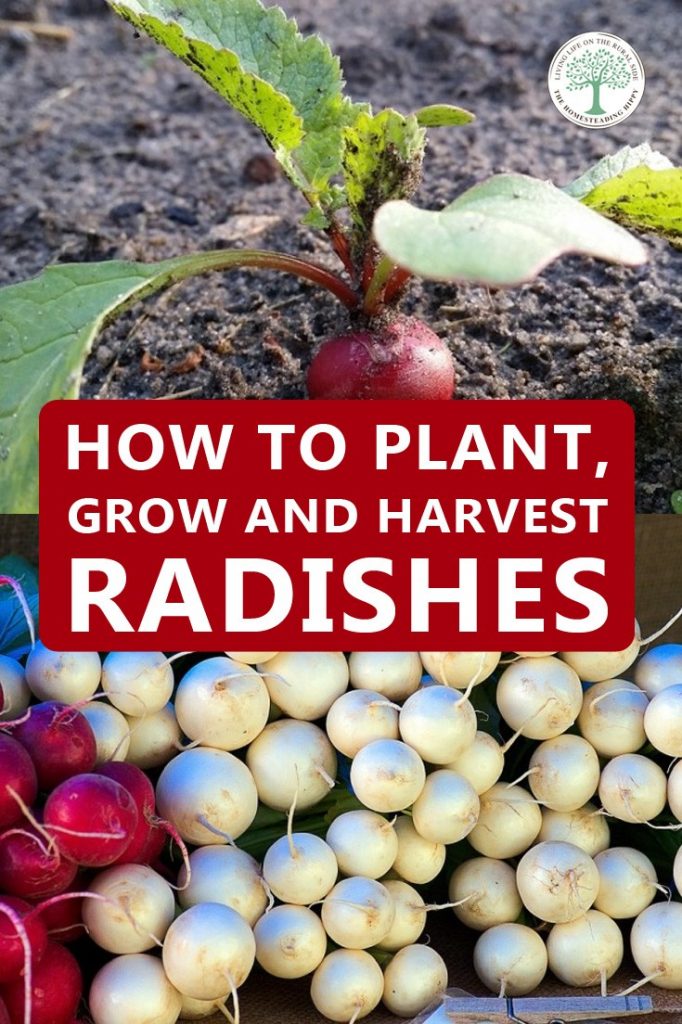

Amanda is a homesteader and a Jesus-loving, mother of 6 toddlers. She’s raising lots of fancy chickens and goats on her small homestead (among other things). Find out more about the team here.

Thank you…just planted radish in pots too early for my area last frost April 15. .you’re information will be quite handy…have you heard of Irish potato plant. .On research I get conflicting information some say its poisonous some say its eatiable.